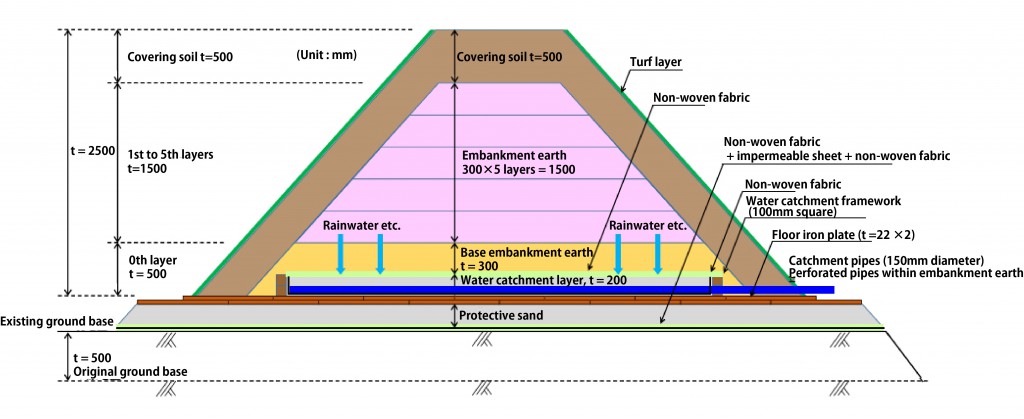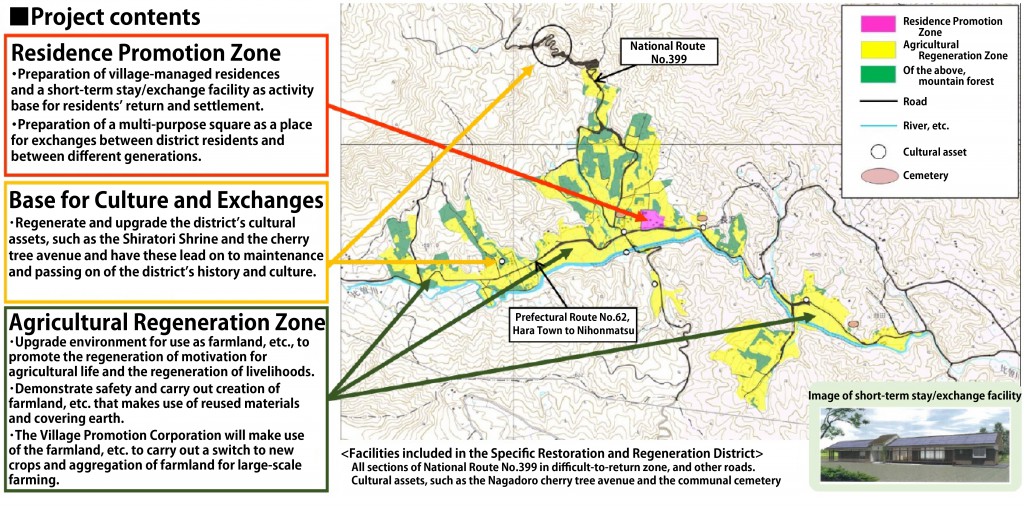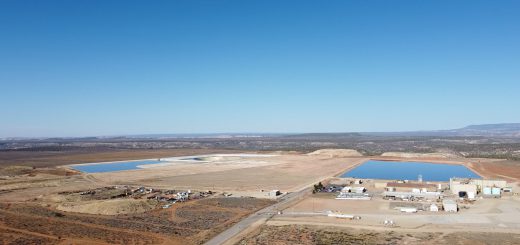Treatment and Disposal of Contaminated Soil
The first “basic thinking” was announced by the Ministry of the Environment (MoE) on June 30, 2016 and has been added to twice since then. The latest version was announced on June 1, 2018 and is available on the MoE website. The official title is “Basic Thinking on the Safe Use of Reclaimed Materials from Removed Soil.” ‘Removed soil’ refers to soil derived from decontamination work. The original plan was to transport this soil to the interim storage facility scheduled to be constructed in the surroundings of the Fukushima Daiichi Nuclear Power Station (FDNPS) and then transport it outside Fukushima Prefecture after 30 years. When it became clear that contaminated soil in Fukushima Prefecture would reach 22 million m3, however, it was thought that “final disposal of the total amount would be unrealistic from the viewpoint of securing, etc. the necessary final disposal sites,” and the “basic thinking” turned to recycling. Since the outlook for attaining agreements to construct final disposal sites outside Fukushima Prefecture is bleak, this was a makeshift plan to reduce, as far as possible, the volume of contaminated soil. Transport of the soil outside Fukushima Prefecture after 30 years was already enshrined in law, but considering that it was nigh on impossible to agree on where it should go, we can therefore say that reducing the amount to be disposed of through recycling is simply a means for straightening out the official story. The “Technological Development Strategy for Volume Reduction and Recycling of Removed Soil in Interim Storage,” announced in April, ahead of the “basic thinking,” clearly stated the target of reducing the volume of contaminated soil to be transported outside Fukushima Prefecture after 30 years to about 10% of the original amount.
According to the “Technological Development Strategy,” it is estimated that of the 22 million m3, roughly half, around 10 million m3, is below 8,000 Bequerel/kg (Bq/kg), about another 10 million m3 is in the range 8,000 to 100,000 Bq/kg, and around 10,000 m3 exceeds 100,000 Bq/kg. Considering the physical decay of cesium, in 30 years’ time, the radiation will have fallen to a quarter of what it originally was (in the case that cesium 134 and 137 were of equal amounts when released during the accident), but that does not bring the total down to 10%. Thus, the technological development for soil treatment is thought to consist of 1) grading sand and gravel from the fine-grain component of the soil (silt and clay) that easily adsorbs cesium and then separating the cesium adhering to the sand and gravel, 2) a chemical treatment method whereby cesium is firstly eluted from the soil by a strong acid, etc., after which the cesium is recovered by an adsorbing agent, and 3) heat treatment, where cesium is volatilized by heating, then cooled and trapped. Each of these has problems and a technological development roadmap has been produced, according to which the basic technological development for all methods is to be completed over a period of ten years. Of these, the grading treatment is a technology that is already available and is positioned as the technological development that will be undertaken first. The general idea is that the amount of soil of 8,000 Bq/kg and below will be increased using the technologies developed and then recycled. The use of the removed soil for recycling, at or less than 8,000 Bq/kg, is to be “limited to embanking materials, etc. as component materials for structural foundations in public works, etc.” Public works is said to have been selected due to “clarity of the management organization and framework for responsibility,” but it is thought that this is due rather to an aim to make the use of removed soil conditional on public bidding. The demonstration projects for the technological development will be implemented in Fukushima Prefecture, but later deployed nationwide.
In 2005, a clearance system was introduced for radioactive waste derived from the demolition of nuclear power facilities. This is a kind of exemption clause. The clearance level is set at a total of 100 Bq/kg. For example, this is the standard to be employed when recycling concrete or steel materials associated with the demolition of nuclear power facilities.
At the same time, the government has enacted the Act on Special Measures concerning the Handling of Contamination by Radioactive Materials1 covering materials or objects contaminated by the radiation dispersed following the FDNPS explosion accidents, making possible the disposal of waste materials of 8,000 Bq/kg or less. Up to now the government has explained that the former is the standard for reuse and the latter is the standard for disposal.
This explanation, however, has been slowly turned on its head until 8,000 Bq/kg has become the standard for reuse. Having done that, and taking the clearance level somewhat into account, the exposure impact on surrounding residents has been limited to 10 microsieverts/year (μSv/yr), and to achieve that the soil is to be used in structural foundations, etc. as embankment material to reduce the exposure dose. There has been no consideration of whether or not the constructions will be able to withstand the massive disasters that have occurred in recent years. There is no guarantee at all that they will.
Exposure to workers has been limited to 1 mSv/yr. This is because there is no necessity to consider these workers to be engaged in work involving radioactivity.
These measures to straighten out the official story are making double standards the normality. In fact, there is the fear that the current clearance standards will be relaxed for certain uses. This creeping relaxation is totally unacceptable.
According to the “basic thinking,” with the aim of verifying the adequacy of the management for limiting additional exposure doses, demonstration projects will be implemented as model projects with the aim of also developing understanding and elevating social acceptance among related persons such as the organizations implementing the projects and local residents, etc. The writing suggests that the aims of the demonstration projects and model projects differ from one another, but the MoE website carries no concrete plan for model projects and it seems that demonstration projects are currently being pushed ahead in advance.
MoE is planning two demonstration projects in Fukushima Prefecture, one in Minamisoma City and one in Nagadoro district, Iitate Village. Further, outside Fukushima Prefecture, projects are positioned as burial disposal demonstration projects, and these are to take place at two locations, Nasu Town, Tochigi Prefecture and Tokai Village, Ibaraki Prefecture. Since the demonstration project at Nihonmatsu City has been cancelled, information about this has been deleted from the MoE website.
The demonstration project at Minamisoma City removed the soil from the flexible container bags in the adjacent temporary storage site, graded it, selected out the material at 3,000 Bq/kg or less, piled it up in five layers, and covered it over with uncontaminated soil. The total amount of recycled soil used was 1,500 tons. The construction work began in 2016 and finished in September 2017. Following that, air dose rate, concentration of radioactive materials in the air and in the water seeping down and collecting in the base of the construction and radiation measurement of effluent rainwater, have been continually carried out. The published measurement results, including during the period when construction was taking place, show an air dose rate at the boundary of the site of 0.04-0.09 μSv/h, a cesium concentration of effluent water at below the minimum detection level (maximum of 7.13 Bq/L), and seepage water below the minimum detection level. This is probably due to the fact that soil with a low degree of contamination was chosen in the first place. Despite having carried out the experiment only with soil of 3,000 Bq/kg, rather than 8,000 Bq/kg, in October 2017, the investigative panel on the Technological Development Strategy for Volume Reduction and Recycling of Removed Soil, set up by MoE, very quickly reached the conclusion that recycling was possible. This conclusion, coming just over two weeks following the completion of the construction can only be said to be a judgement made without sufficient examination of the results.
t = thickness
In the case of Iitate Village, the soil recycling demonstration project is positioned as “agricultural regeneration” in the Nagadoro district reconstruction and regeneration plan (official name: Reconstruction and Regeneration Plan at a Specific Reconstruction and Regeneration Base). The evacuation order for Iitate Village was rescinded on April 1, 2017, but Nagadoro district was classified as a difficult-to-return zone where the evacuation order remained in force. The village, aiming to have the evacuation order cancelled at an early date, must carry out decontamination, but a Specific Reconstruction and Regeneration Base plan is a necessity for decontamination of the difficult-to-return zone. Iitate Village formulated the plan, which received approval from the government (Reconstruction Agency) on April 20, 2018.
The plan here is to recycle the contaminated soil in Iitate Village, and by laying it down in a layer of several tens of centimeters to around one meter, reduce to one half the contaminated waste in the village (estimated at 2.2 million bags). The project aims to lay down soil of 5,000 Bq/kg or less on farmland and cover it over with 50 cm of uncontaminated soil to regenerate the farmland. Even though the farmland is said to be regenerated, the plan is said to call for the cultivation of flowers. The area is 140 hectares (ha, 1.4 million m2), which will total 186 ha in the reconstruction and regeneration plan when the decontamination of roads and residential areas are included. The housing area decontamination will not cover the residential land of individuals, but the decontamination of a residence promotion zone (roughly 10 ha). A facility for grading and radioactivity measurement of soil will be built in one corner of the agricultural regeneration zone. When the author visited the location in July this year, a part of the flexible container bags in Iitate Village had been carried to the site, but construction of the facility for grading and other associated work had not yet begun. It also appears that the concrete plan for the creation of farmland using the recycled soil is still in preparation.
Management and the burden of management costs of the created farmland will be borne by the landowners. The plan faces many problems, since it may be doubted that the landowners will be able to bear the costs. As seen below, with few wishing to return there are doubts about whether agriculture can, in fact, be regenerated.
Nagadoro district is an area at the southeastern tip of Iitate Village. Taking Route No.399 from the village center, the Pacific Ocean can be glimpsed from the pass as you enter the district. I was reminded of the radiation released by the explosion accidents that was carried on the wind directly from the crippled nuclear plant.
The pre-accident population was 262 people in 72 households (2010 statistics). According to the Specific Reconstruction and Regeneration plan, the target for returnees is 180 people and the cancellation of the difficult-to-return zone is scheduled for 2023. However, this target figure is a very high hurdle. The district head, Mr. Yoshitomo Shigihara, who showed me around, estimates the actual figure for returnees will be around ten people. According to a survey of Iitate Village residents’ intentions conducted by the Reconstruction Agency in January 2017, of the 51 respondents from Nagadoro district, those wishing to return were 19.6%, around ten people, so Mr. Shigihara may be about right. The Iitate Village survey has not been repeated since.
Further, the farm management target is said to be 20 households, but this will be an extremely high hurdle if there are only about ten people wishing to return. Apparently, countermeasures for this are being considered, and the plan, in addition to the 20 households, also contains mention of planting and farm management by an Iitate Village Promotion Corporation (representative Norio Kanno, Mayor of Iitate Village). Thus, even if the target figure for households is not reached, the corporation will plant and manage the farmland under contract from the landowners.
The original go-ahead for the demonstration project at Nihonmatsu City was decided by a handful of influential figures and proceeded without the citizens knowing hardly anything about it. Later, the local residents and people in surrounding areas became aware of the situation, starting up an opposition movement which led to the cancellation of the project. As can be understood from this case, it is hard to say that adequate information is provided to residents in advance when there are plans for demonstration projects and that the projects proceed on the basis of agreements with local people. Rather, it seems that by not providing information and going ahead without local agreement, and by starting up one project after another, authorities are attempting to slowly force people into acquiescence.
What is the situation at Nagadoro district? According to media reports2, local people stated, “We left on the promise that decontamination would be carried out without fail before we returned.” But because of the designation of the difficult-to-return zone, decontamination has not been implemented. Even when it was demanded, only an extremely small area of about three hectares was decontaminated. The evacuees are thus having to make a “bitter decision” as they are faced with the stark reality that contamination cannot be carried out unless they accept the soil recycling.
1. The official name is “The Special Act on Coping with Contamination of the Environment due to the Release of Radioactive Substances from the Nuclear Power Plant Accident that Occurred in Association with the Tohoku Region Offshore Pacific Ocean Earthquake on March 11, 2011.
2. NHK, News Watch 9, Bitter Choice of the “Hard-to-Return Zone” of Nagadoro District, Iitate Village, March 9, 2018.



